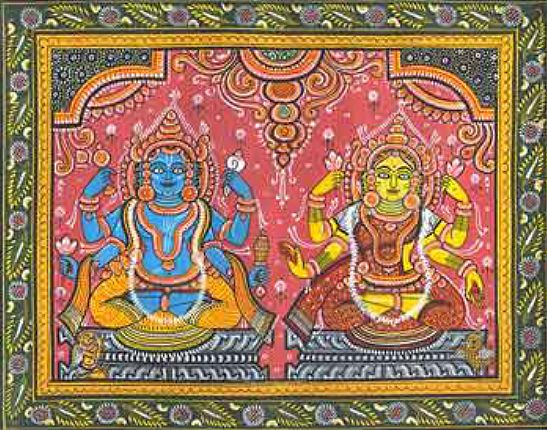 Advaita Vedanta Philosophy
Advaita Vedanta Philosophy
Every human being goes through the various experiences of unhappiness and discontentment; starting in infancy when the feeling of hunger is felt or the mother is missed. All through life people feel that something is missing and desire more. No matter how much a person possesses materially, they never feel they have enough. People are afraid to die and they want to live longer, be healthier, look younger and accumulate more wealth. They want to increase their knowledge and personal awareness. They want to experience more joy and happiness.
All these desires lead a person to unbearable restlessness and ultimately, a miserable life. The answer for living a happy life lies in the three statements comprising the wonderful formula given to us by Sri Sankaracharya, the exponent (explainer and clarifier) of advaita vedanta.
“Brahma Satyam
Jagan Mithya
Jivo Brahmaiva Na Parah”
Sri Shankaracharya
which translates as follows:
“God alone is real.
The world is illusory.
The individual is none other than God.”
Sri Shankaracharya
Advaita – Non Dualism
This means that there is only one supreme reality, a reality called Brahman, the supreme being. Brahman is infinite and omnipresent (present absolutely everywhere), therefore nothing can be added to it and furthermore, there cannot be a place where he is not. Therefore, Brahman being non-dual in nature, there is no place for the world or man or any creature outside Brahman. It transcends all pairs of opposites and descriptions.
The reality of the world, or jagat, is then relative as opposed to the absolute nature of Brahman. In that sense, and in comparison with Brahman, the world is unreal. By unreal is meant illusory, very much like a dream, which has its own subjective reality but which is illusory compared with the waking state.
The last of the three statements asserts that the true nature of each individual is Brahman. Because of avidya, the orginal spiritual ignorance, we have forgotten our true identity and mistakenly believe that we are little, limited individuals.
The Solution
The practical application of advaita vedanta is jnana yoga, the yoga of knowledge or wisdom. It is the direct path to experiencing the truth of advaita, meaning to realize your true Self, the atman.
Jnana yoga being the most difficult of all yogas, many other practices can be done to help us reach the goal, self realization. These techniques are the different yogas, including hatha yoga, and categorized into four paths.
Sat-Chit-Ananda Brahman
Although Brahman is beyond description, the Rishis (seers or sages) of yore declared, based on their personal experience, that it can best be described as sat-chit-ananda.
Sat means existence pure and absolute.
Chit means knowledge, or consciousness, pure and absolute.
Ananda means bliss, pure and absolute.
Our true nature is pure existence, knowledge and bliss. Deeply we know it and because of this we cannot settle for being mortal and experiencing any types of limitation to our existence. We have an infinite thirst for knowledge and constant yearning to experience joy.
Yoga is looking for happiness in the Self, the atman, instead of outside ourselves, in the sense objects.
Snake & Rope Analogy
A man, let us call him Rob, walks at night on a dark path. All of a sudden, a snake bites him on the leg. The snake is lying on the ground just a few feet from him.
Lying on the floor, he weeps because of the pain and knowing that his life is most likely over. He can feel the poison traveling in his bloodstream and he cries for help.
The nearby farmer hearing him, comes with a flashlight and pointing it to the snake, lo and behold, the snake turns out to be nothing more than a rope.
Superimposition
This analogy illustrates the concept of superimposition. Rob, due to his fear of snakes, superimposed a snake upon the rope. He had just been touched by a branch, and the sight of the rope was enough to create the imaginary presence of the snake and pain of the venom.
Now the question is: during the incident, was the snake real or unreal? The answer is that, subjectively, the snake was very real to Rob. However, objectively, the presence of the snake was all illusory and created by Rob’s mind.
Similarly, this world has its own subjective reality, but upon dawning of the knowledge of Brahman, this relative reality subsides and only the absolute reality of Brahman remains.
In the story, the snake existed only at the time of the incident (the present), while the rope existed in the past (before the incident), the present, as well as the future (after the incident).
Likewise, the world exists in the present moment only – although it is a pretty long moment – while Brahman existed before the creation of the world, exists in the present, and will still exist for ever after the universe’s dissolution.
Maya & Avidya
Brahman is both consciousness and power (shakti). This sakti operates in many ways, including the power or creation. One such power is the veiling power which veils the spiritual truth of the oneness of consciousness.
Maya sakti creates the ignorance of perception of separateness and diversity of objects in this world. She makes us believe that we are different from the world and all other beings. She makes us identify with our Upadhis, bodies, which are imperfect and bring pain to our life.
Reference: Advaita Yoga Ashrama
